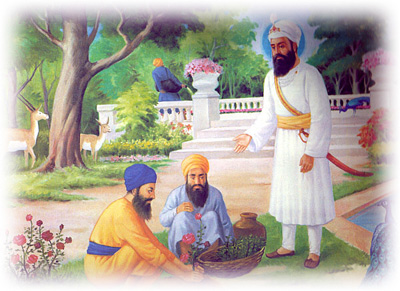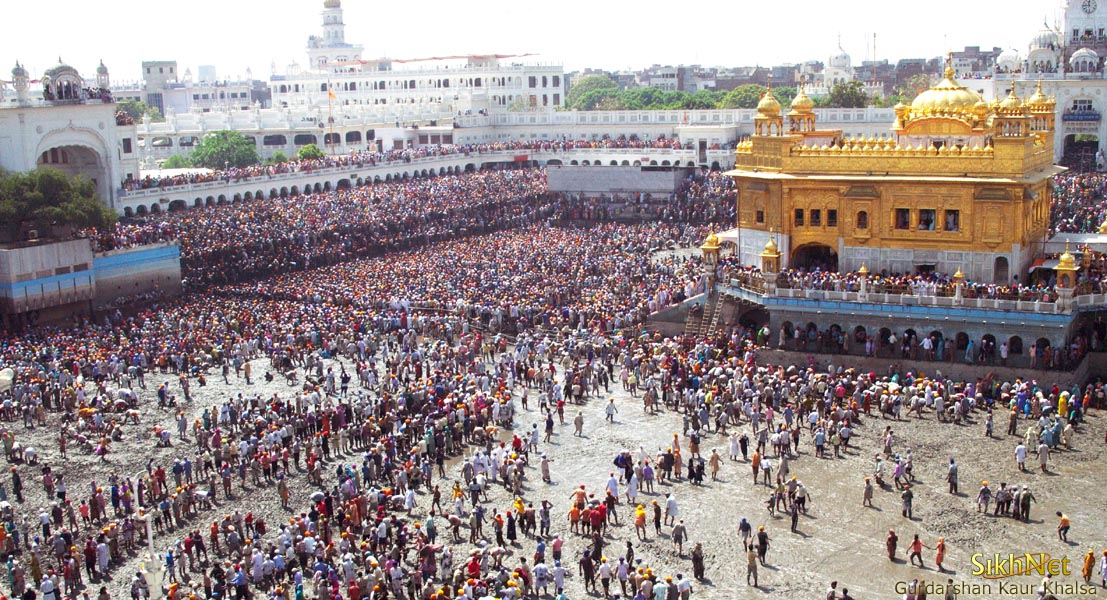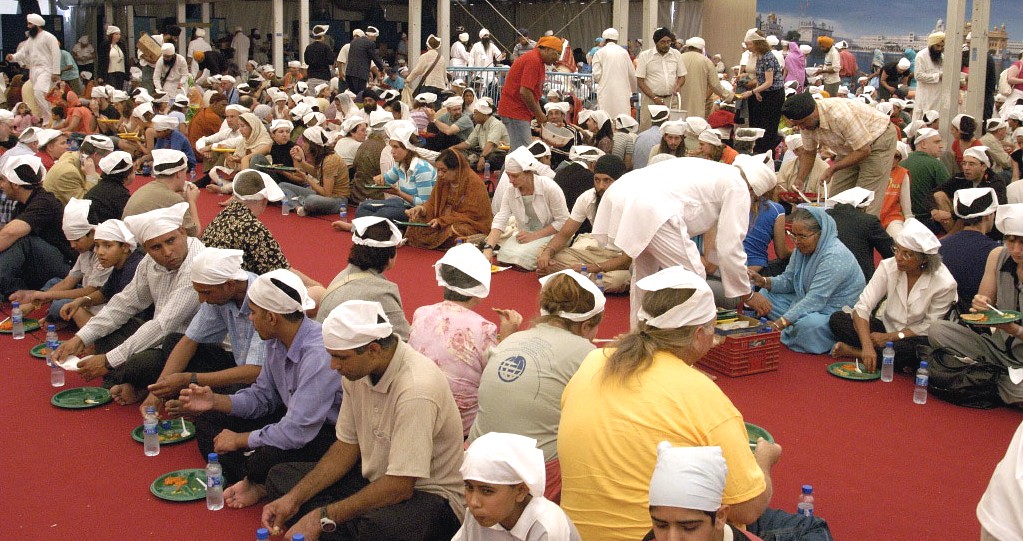Sikhism and the environment
"The Lord infused His Light into the dust, and created the world, the universe. The sky, the earth, the trees, and the water - all are the Creation of the Lord. ||1||" SGGS page 723
The Sikh scripture, Guru Granth Sahib, declares that the purpose of human beings is to achieve a blissful state and to be in harmony with the earth and all of God's creation. It seems, however, that humans have drifted away from that ideal. For the earth is today saturated with problems. It is agonizing over the fate of its inhabitants and their future! It is in peril as never before. Its lakes and rivers are being choked, killing its marine life. Its forests are being denuded. A smoky haze envelops the cities of the world. Human beings are exploiting human beings.
The Sikh Gurus showed the world the way to live in harmony with the environment and all their constructions adhered to this principle. Guru Har Rai, the seventh Sikh Guru developed Kiratpur Sahib as a town of parks and gardens. Located on the banks of tributary of the Sutlej, he planted flowers and fruit bearing trees all over the area. This created a salubrious environment, attracting beautiful birds to the town and turning it into an idyllic place to live in. The Sikh Scriptures emphasis the importance of the elements in this Shabad (hymn):
| Pauṇ gurū pĝṇī piṯĝ mĝṯĝ ḝẖaraṯ mahaṯ. Ḏinas rĝṯ ḝuė ḝĝī ḝĝiĝ kẖėlai sagal jagaṯ. Cẖangĝīĝ buriĝīĝ vĝcẖė ḝẖaram haḝūr. Karmī ĝpo ĝpṇī kė nėṛai kė ḝūr. |
| Air is the Guru, Water is the Father, and Earth is the Great Mother of all.
Day and night are the two nurses, in whose lap all the world is at play. |
The importance of Air, Water and Earth to life are emphasised over and over again in the Sri Guru Granth Sahib. The earth is referred to as the mother and as such requires the our respect. Great care needs to be taken to ensure that no damage occurs to it while the Sikh is going about his or her daily life. The pollution of these 3 elements is against the principles laid down by the Gurus. On page 723, the Guru says:
| ਪਉਣ ਪਾਣੀ ਧਰਤੀ ਆਕਾਸ ਘਰ ਮੰਦਰ ਹਰਿ ਬਨੀ ॥ |
| Pauṇ pĝṇī ḝẖarṯī ĝkĝs gẖar manḝar har banī. |
| Air, water, earth and sky - the Lord has made these His home and temple. |
Air, water earth and sky are God's home and temple - sacred places which need to be protected and looked after. The Sikh Gurus built many Gurdwaras surrounded by large pools which supported marine life, especially fish. This was clearly a sign to live in harmony with nature rather than in conflict with it.
Further, Gurbani refers to various species of trees, eulogising species, which are useful to the world and its various beings and creatures. The Gurus inferred that it is not the girth, size, or beautiful flowers that determine the significance of a tree but its usefulness that makes it important. The trees that have sanctity in Sikhism include Bohr (Ficus bengalensis), Pipli (Ficus religiosa), Jand (Prosopis spicigera), Garna (Capparis horrida), Karir (Capparis aaphylla), Phalahi (Acacia modeta), Reru (Mimasa leucophloea), Luhura (Cordia latifolia), Tahli (Shisham), Imli (Tamarind), Amb (Mangifera indica), Harian velan, Neem (margassa), Ritha (Sapindus mukorosa), Kalp (Mitragina parvifolia) and Ber (Zizyphus jujube). Perhaps no other religion has given importance to vegetation the way Sikhism has. Four of the most sacred trees associated with the Sikh shrines, namely beri of Dukh Bhanjani Beri of Sri Harmandir Sahib, Beri of Baba Budha (also of Sri Harmandir Sahib), Beri of Gurdwara Ber Sahib of Sultanpur Lodhi and Beri of Lachi Ber of Sri Harmandir Sahib highlight the role that trees have played in Sikh history. The world started talking about environment and ecological balance only during the past three to four decades while the Gurus realised their significance more than 500 years ago.
Crisis in the World
There is a sense of crisis in all parts of the world, in various countries and among various peoples. The demands of national economic growth and individual needs and desires are depleting the natural resources of the earth.
There is serious concern that the earth may no longer be a sustainable biosystem. The major crises facing the earth—the social justice crisis and the environmental crisis—together are heading the earth toward a disastrous situation. The social justice crisis is caused by humanity’s confrontation with itself and the environmental crisis is caused by humanity’s confrontation with nature.
The social justice crisis is that poverty, hunger, disease, exploitation, and injustice are widespread. There are economic wars over resources and markets. The rights of the poor and the marginal are violated. Women, constituting half the world’s population, have their rights abused.
The environmental crisis caused by humanity’s exploitation of nature is leading to the depletion of renewable resources, destruction of forests, and overuse of land for agriculture and habitation. Today pollution is contaminating air, land, and water. Smoke from industries, homes, and vehicles is in the air. Industrial waste and consumer trash is affecting streams and rivers, ponds and lakes. Much of the waste is a product of modern technology; it is not biodegradable and not reusable, and its long-term consequences are unknown. The viability of many animal and plant species, and possibly that of the human species itself, is at stake.
A Sikhi Solution
This crisis cries out for an immediate and urgent solution. The crisis requires going back to the basic question of the purpose of human beings in this universe and an understanding of ourselves and God’s creation.
We are called to the vision of Guru Nanak which is a World Society comprising God- conscious human beings who have realized God. To these spiritual beings the earth and the universe are sacred; all life is unity, and their mission is the spiritualization of all.
Guru Nanak in his philosophy states that the reality that humans create around themselves is a reflection of their inner state. The current instability of the natural system of the earth—the external environment of human beings—is only a reflection of the instability and pain within humans. The increasing barrenness of the earth’s terrain is a reflection of the emptiness within humans.
The chasm between the material and the spiritual is in the minds of humans only. It is a limitation of the human condition that spirit and matter appear as duality, and their unity is not self-evident.
Creation of God
The material universe is God’s creation. Its origin was in God and its end is in God, and it operates within God’s hukam. Guru Nanak declares that God alone knows the reasons for and the moment of earth’s creation. The origin of the universe is unknowable. The act of creation itself, the creation of the primeval atom, was instantaneous, caused by the Will of God.
The Sikh Guru reveals that real peace can only be found when desire and greed are subdued and diminished. This will only happen when the individual realises that God is found in all the elements including water, earth and the woods and he stops damaging these elements purely to satisfy his material greed.
| ਸਾਂਤਿ ਪਾਵਹਿ ਹੋਵਹਿ ਮਨ ਸੀਤਲ ਅਗਨਿ ਨ ਅੰਤਰਿ ਧਖੀ ॥ ਗਰ ਨਾਨਕ ਕਉ ਪਰਭੂ ਦਿਖਾਇਆ ਜਲਿ ਥਲਿ ਤਰਿਭਵਣਿ ਰਖੀ ॥੨॥੨॥੩੦॥ |
| Sĝʼnṯ pĝvahi hoveh man sīṯal agan na anṯar ḝẖukẖī. Gur Nĝnak kao parabẖū ḝikẖĝiĝ jal thal ṯaribẖavaṇ rukẖī.((2)(2)(30)) |
| You shall find peace, and your mind shall be soothed and cooled; the fire of desire shall not burn within you. The Guru has revealed God to Nanak, in the three worlds, in the water, the earth and the woods. ((2)(2)(30)) |
Further descriptions of the universe and its creation in Sikh scripture are remarkably similar to recent scientific speculation about the universe and its origin. One of the basic hymns in the Sikh scripture, which may be called the Hymn of the Genesis, describes the indeterminate void before the existence of this universe.
Limitless Galaxies

Guru Nanak speaks of innumerable galaxies, of a limitless universe, the boundaries of which are beyond human ability to comprehend. God alone knows the extent of creation.
God created the universe and the world, for reasons best known to Him. And being the results of God’s actions all parts of the universe are holy. God is an all-pervasive being manifest through various elements of creation.
Having created this universe and the world, God directs them. All actions take place within God’s hukam. God alone knows how and why. God, however, not only directs this vast and massive theater, but also watches over with care and kindness—the benign, supportive parent!
"Men, trees, pilgrimage places, banks of sacred streams, clouds, fields. Islands, spheres, universes, continents, solar systems. The sources of creation, egg-born, womb-born, earth-born, sweat-born, oceans, mountains and sentient beings. He, the Lord, knows their condition, O Nanak. Nanak, having created beings, the lord takes care of them all. The Creator who created the world, He takes thought of it as well. " (SGGS 466)
The world, like all creation, is a manifestation of God. Every creature in this world, every plant, every form is a manifestation of the Creator. Each is part of God and God is within each element of creation. God is the cause of all and He is the primary connection between all existence.
“The Creator created himself ... And created all creation in which He is manifest. You Yourself the bumble-bee, flower, fruit and the tree. You Yourself the water, desert, ocean and the pond. You Yourself are the big fish, tortoise and the Cause of causes. Your form cannot be known.” (SGGS 1016)
In the world God has created he has also provided each species and humans with means of support and nurturing.
In Sikh beliefs, a concern for the environment is part of an integrated approach to life and nature. As all creation has the same origin and end, humans must have consciousness of their place in creation and their relationship with the rest of creation. Humans should conduct themselves through life with love, compassion, and justice. Becoming one and being in harmony with God implies that humans endeavor to live in harmony with all of God’s creation.
Spiritual discipline
The second postulate is that humans, practicing a highly disciplined life, while remaining active in the world, are capable of further spiritual progression. It is important that Sikhs retain the primacy of spirit over matter, while it is desirable that they do not deny matter or material existence. It is not required that humans renounce the world. They must maintain their life in the world and uphold all responsibilities in the world. Humans should be renouncers of plenty and maintain a simple life. Further spiritual progress fundamentally starts with an individual conquering himself/herself with the guidance of the Guru.
The emphasis is on mastery over the self and the discovery of the self, not mastery over nature, external forms, and beings. Sikhism teaches against a life of conspicuous, wasteful consumption. The Guru recommends a judicious utilization of material and cultural resources available to humans.
“Then why get attached to what you will leave behind. Having wealth, you indulge in pleasures bout, From that, tell me, who will bail you out? All your houses, horses, elephants and luxurious cars, They are just pomp and show, all totally false.”.
The Gurus taught humans to be aware of and respect the dignity in all life, whether human or not. Such a respect for life can only be fostered where one can first recognize the Divine spark within oneself, see it in others, cherish it, nurture and fulfil it.
”This little shrine of the human body! This great opportunity of life! The object is to meet the Beloved, thy Master!”
Humans have the capability to further their spiritual progression through conscious choice and it is important to identify the method by which they might do so. The method suggested by Guru Nanak is one of spiritual discipline, meditation and prayer, and sharing. Sikhism emphasizes mastering five negative forces: Lust, Anger, Worldly or Materialistic Attachment, Conceit, and Greed. These together constitute what Sikhs term Haumai—“I am-ness.” Mastering Haumai is achieved by developing five positive forces: Compassion, Humility, Contemplation, Contentment, and Service (seva) without expecting any material or spiritual reward.
The guiding principles are Love and Forgiveness. Every decision in life has to be based on Rationality and a personal code of ethics. Guru Nanak’s philosophy of values inspires the individual to transcend his/her existence through this spiritual discipline. Sikh religion preaches strong family involvement. A person pursuing this spiritual discipline must also work to create an atmosphere for other members of the family to progress spiritually.
The ideal Sikh has an intense desire to do good
The third postulate is that the true end of human beings is in their emergence as God-conscious beings, who remain aware of the earth and operate in the mundane material world, with the object of transforming and spiritualizing it into a higher plane of existence. In this spiritual state individuals are motivated by an intense desire to do good, transforming their surroundings.
Through a life based on the method prescribed by the Gurus humans may achieve a higher spiritual state. Such truly emancipated, valiant, and enlightened spirits (jivan-mukta, brahma-gyani) become the true benefactors of humanity and the world around them. Such an individual would not exploit another human or sentient being, as each is a manifestation of the eternal and the supreme. In this God-conscious state they see God in all and everything.
“I perceive Thy form in all life and light; I perceive Thy power in all spheres and sight.” (464)
Spiritualization is a liberation from material compulsions and attractions. It means an awareness of the Cosmic Order and striving toward the execution of Divine Will. So, the spiritualized human is creative and constructive. Therefore a Sikh life is a life of harmony with other individuals, with other beings, and with other forms. For an enlightened individual the world has only one purpose: to practice spirituality. That is the ultimate objective of all humans.
Such a person is involved in human problems and society and has to prove his or her effectiveness there. Such a person lives with a mission—and works for the emancipation of all. A true Sikh is for individual human rights, the environment, and justice for all.
“The God-conscious person is animated with an intense desire to do good in this world.” (273)
Practicing the philosophy
Integrated approach: Care of the environment without social justice is not possible
Environmental concerns may be viewed as part of the broader issue of human development and social justice. Many environmental problems, particularly the exploitation of environmental resources in developing nations, are due to the poverty of large parts of the population. Therefore an integrated approach is necessary.
Sikhism opposes the idea that the struggle of the human race is against nature and that human supremacy lies in the notion of “harnessing” nature. The objective is harmony with the eternal—God—which implies a life of harmony with all existence. Striving for a life of harmony, therefore, also implies a life of supporting individual rights and environmentalism—a life that works against injustice toward anybody and anything.
The tenth Guru in 1699 founded the Order of the Khalsa, whose members practice the spiritual discipline of Sikhism and are committed to ensure the preservation and prevalence of a World Society. Over the last three centuries the members of the Khalsa order have stood up for the rights of the oppressed and the disenfranchised even at the cost of their own lives. The Khalsa vision of the World Society is:
“Henceforth such is the Will of God: No man shall coerce another; No person shall exploit another. Each individual has the inalienable birthright to seek and pursue happiness and self-fulfillment. Love and persuasion is the only law of social coherence.” (74)
The Khalsa have opposed any force that has threatened the freedom and dignity of human beings. In the eighteenth century it was the oppressive rulers of northern India, and invaders from Afghanistan; in the nineteenth and twentieth centuries they have struggled against oppression by European colonists and Indian governments. For the Khalsa, justice requires the participation and inclusion of all in obtaining and enjoying the fruits of God’s creation. Justice achieved through cooperative effort is desirable. The ideal for the Khalsa is to strive for justice for all, not merely for themselves.
The institutions of sangat, pangat, and langar
The Sikh Gurus, through their lives, provided role models for the Sikhs. They all actively worked to stress the equality of all humans and challenged the rigid social stratification of the caste system in India. The very existence of the Sikh religion is based on challenging:
- Inequality in society, and
- The exploitation of the poor and the marginal by the religious and political establishment.
Sikh Gurus provided many examples of standing by their principles and confronting exploitation and oppression. They stood by the “low” and the “poor,” for, as Guru Nanak said:
"There are the lowest men among the low castes. Nanak, I shall go with them. What have I got to do with the great? God’s eye of mercy falls on those who take care of the lowly." (15)
Sikh Gurus challenged the status quo and came into conflict with the entrenched elite—political, social, religious, and economic. The Gurus were most sympathetic to the downtrodden of society, the untouchables and those of lower caste. They vehemently opposed the division of society on the basis of caste, which had been and is still significantly present. They identified themselves with the poor in full measure and were critical of those responsible for their misery. In the course of their travels they preferred to live in the homes of those who made an honest living rather than in the homes of the rich who thrived on exploitation.
Two Sikh Gurus were martyred by the regimes of their period for challenging the contemporary authorities. One of them, Guru Tegh Bahadur, was martyred when he stood up for the religious freedom of the Hindu inhabitants of Kashmir who were being forced to accept Islam by the rulers.
Sikh Gurus also molded traditional lifestyles to exemplify a more equitable society. They created many institutions that form the basis of Sikh society and are based on the equality of all. The Sikh Gurus invited people of all castes and creeds to meditate together. That would be called sangat. Either before or after the meditation, people were asked to sit and eat together irrespective of their social background, to create a sense of equality. That process would be called pangat.
Sikh Gurus started a tradition of free distribution of food to the rich or poor through the Sikh meeting areas. That would be called langar. These three ideas were in contrast to the practices of Indian society, which had separate temples or water wells for social outcasts. These changes by the Sikh Gurus created a lot of opposition from the religious establishment, but they remain much alive in Sikh practices today. Through the creation of the Khalsa, the Gurus established a system that would protect and maintain a free and just order.
Equality of women
Women and their rights have been ignored for too long. Any approach to solving problems of social justice and the environment must be sensitive to women’s concerns, and must include women as equals.
Often piecemeal solutions to environmental problems focus on limiting population growth and on family planning programs. Most family planning measures end up abusing women’s rights and should be rejected on those grounds alone. Meanwhile they spread mistrust of family planning among women.
Guru Nanak and other Sikh Gurus during their lives advocated equality and dignity of women and took steps to implement these principles. Guru Nanak denounced the idea that spirituality was only for men, and not for women. The first Sikh Guru in his preaching and writings made direct statements emphasizing that women were no less than men:
”After the death of one’s wife, one seeks another, and through her social bonds are cemented. Why should we condemn women who give birth to leaders and rulers? Everyone is born of a woman and a woman alone. Nobody is born otherwise. God alone is an exception to this rule.” (473)
Guru Amar Das strongly opposed the custom of sati in the sixteenth century and also advocated widow marriages. Sati was the Indian practice whereby a widow burned herself with her husband’s corpse at cremation. Guru Amar Das appointed and ordained a large number of women preachers, and at least one female bishop, Mathura Devi, 400 years ago. The Sikh Gurus also raised their voice against the purdah or veil. Guru Amardas did not even allow the Queen of Haripur to come into the religious assembly wearing a veil.
The immediate effect of these reforms was that women gained an equal status with men. Those who lived as groveling slaves of society became fired with a new hope and courage to lift themselves to be equals of the best in humanity. The spirit of the Sikh woman was raised with the belief that she was not a helpless creature but a responsible being endowed with a will of her own, with which she could do much to mold the destiny of society.
Women came forward as the defenders of their honor and dignity. They also became the rocks that stood against tyrants. Without the burden of unnecessary and unreasonable customs, Sikh women became the temporal and spiritual supporters of men, often acting as the “conscience of men.” Sikh women proved themselves the equals of men in service, devotion, sacrifice, and bravery.
Since the late nineteenth century, Sikh community organizations have made efforts to expand educational opportunities for all. Individual Sikhs, men and women, in various cities and towns took the initiative to start and operate women’s colleges and schools. Women’s education was part of the drive to improve education among the Sikhs, initiated by Sikh organizations in the 1920s. In towns and villages in the Punjab, and in cities with significant Sikh populations, there exist schools and colleges operated by Sikh organizations.
Community-based sharing of resources
Traditional modes of farming and traditional modes of life in northern India have been dependent upon limited resources. As there exist circumstances where large numbers of people depend upon relatively scarce resources, the traditional lifestyle ensures use of the least resources, considerable reuse, and recycling. In a culture based on organic materials, recycling is an intrinsic and natural part of the resource cycle. There are strong traditions of sharing.
There have been traditional practices that maintained lands and forests as community property within proximity of human habitation. For instance, in traditional rural India and Punjab, two of the most important centers of human activity have been the Sikh gurudwara and a source of water—pond, tank, pool, or running water. Both of these sites were surrounded by community land, not owned by anyone and not used for agriculture. This was where there were trees and plants, such as groves or small forests. They provided shade and shelter, and were a source of firewood within easy reach of habitation.
The Gurus established towns and cities, each created around a religious center. The focus was on a lifestyle based on sharing: a lifestyle that promoted equity among people, and optimum utilization of resources. Even today, rural Punjab families share resources with their neighbors. This is particularly evident on large family occasions such as weddings, when the entire village may play host to guests and share living space, beds, and so on.
Most gurudwaras in India were specifically designed to have a water tank, or were near running water (rivers or pools), which were always considered a community resource. For instance, Amritsar grew up around the Harimandir (ordinarily referred to as the Golden Temple) and the Amrit Sarovar (the pool of nectar, that is, the water). The cities and towns that grew around gurudwaras were ideally centered on a spiritual lifestyle based on sharing.
Since the time of the Gurus, Sikh gurudwaras have included institutionalized practices that emphasize sharing of resources. Gurudwaras, in addition to being places where people congregate for prayer and meditation, are a place to stay for travelers and others; a community kitchen (Langar); a place for dispensing medication and medical care; and a place to impart education to the young. Gurudwaras have always been places of shelter for travelers and visitors, and most major gurudwaras have rooms where visitors may stay. In addition Sikh gurudwaras stock extra beds, sheets, pots and pans, etc. At weddings and other family events, the gurudwaras are a source for borrowing these items.
There has always been great emphasis on avoiding waste. Traditionally the community kitchen served food on plates made from leaves and cups made from clay. Today they tend to use steel plates and utensils that are reused. The kitchens have always been stocked by ordinary people—farmers, traders, others in the community—on a voluntary basis.
Simple Diet which is Free of Intoxicants
"Those who do not use intoxicants are true; they dwell in the Court of the Lord. ||1||" SGGS page 15
Guru Sahib has shown a Sikh to live a life which does not harm their mind, health, others around them, society, or the environment. Therefore, Sikhs are prohibited from consuming tobacco, alcohol or any other intoxicant, and keep a simple vegetarian diet. Gurmat is against causing cruelty and suffering to animals. The prohibiton of not to eat "Kuttha", interpreted to mean: "meat of an animal that has been 'butchered' and then 'intentionally' eaten." The reason is NOT because of Ahimsa (respect for life), but instead “Daya” (compassion). If one's heart doesn't melt at seeing the shrieks and angusih of animals, why would it matter when a human does the same? If one cannot have love for God's creation and create a spiritual and kind atmosphere and environment within themselves and around them, then how can one expects to experience or connect with God?
"Kabeer, those mortals who consume marijuana, fish and wine - no matter what pilgrimages, fasts and rituals they follow, they will all go to hell. ||233||" SGGS page 1377
Sikhism against Smoking
It is now a known fact that smoking is both a primary and secondary health hazard. In addition to harming the environment, it has seriously deleterious effects on the person who smokes, on the bystander who breathes the secondhand smoke, and on the unborn fetus of the female smoker. Though this has only been scientifically verified in the last half century, Guru Gobind Singh, the last living Guru of the Sikhs, listed the use of tobacco as one of the four major acts forbidden to initiated adherents of the Sikh religion. Though tobacco was introduced into India only in the mid-1600s, he had the wisdom to specifically interdict it in 1699. From its very beginning, Sikhism had forbidden the use of any intoxicants or mind-altering substances for any purpose, except medicinal.
Conclusion
The ideal for Sikhism is a society based upon mutual respect and cooperation and providing an optimal atmosphere for individuals to grow spiritually. Sikhism regards a cooperative society as the only truly religious society, as the Sikh view of life and society is grounded in the worth of every individual as a microcosm of God. Therefore, an individual must never be imposed upon, coerced, manipulated, or engineered:
”If thou wouldst seek God, demolish and distort not the heart of any individual”. (1384)
All life is interconnected. A human body consists of many parts; every one of them has a distinct name, location, and function, and all of them are dependent upon each other. In the same way, all the constituents of this universe and this earth are dependent upon each other. Decisions in one country or continent cannot be ignored by others. Choices in one place have measurable consequences for the rest of the world. It is part of the same system.
Life, for its very existence and nurturing, depends upon a bounteous nature. A human being needs to derive sustenance from the earth and not deplete, exhaust, pollute, burn, or destroy it. Sikhs believe that an awareness of that sacred relationship between humans and the environment is necessary for the health of our planet, and for our survival. A new “environmental ethic” dedicated to conservation and wise use of the resources provided by a bountiful nature can only arise from an honest understanding and dedicated application of our old, tried and true spiritual heritage.
- The above article based on articles by Dr Rajwant Singh and Bhai Manvir Singh
Other Shabads
1.
| ਖਾਕ ਨੂਰ ਕਰਦੰ ਆਲਮ ਦਨੀਆਇ ॥ ਅਸਮਾਨ ਜਿਮੀ ਦਰਖਤ ਆਬ ਪੈਦਾਇਸਿ ਖਦਾਇ ॥੧॥ |
| Kẖĝk nūr karḝaʼn ĝlam ḝunīĝė. Asmĝn jimī ḝarkẖaṯ ĝb paiḝĝis kẖuḝĝė.(1) |
| The Lord infused His Light into the dust, and created the world, the universe.
The sky, the earth, the trees, and the water - all are the Creation of the Lord. (1) |
2.
| ਨਰਨਰਹ ਨਮਸਕਾਰੰ ॥ ਜਲਨ ਥਲਨ ਬਸਧ ਗਗਨ ਝਕ ਝਕੰਕਾਰੰ ॥੧॥ ਰਹਾਉ ॥ |
| Narnarah namaskĝraʼn. Jalan thalan basuḝẖ gagan ėk ėkaʼnkĝraʼn.(1)rahĝo. |
| I humbly bow to the Lord, the Supreme Being. The One, the One and Only Creator Lord permeates the water, the land, the earth and the sky. ((1)(Pause)) |
External Links
- Sikhism the Green Religion - (Opinion by By Jagtaran Singh)





